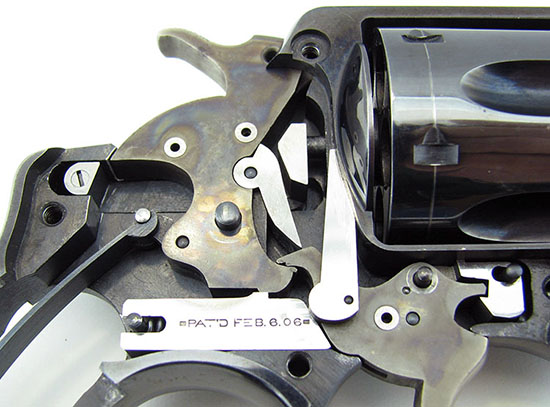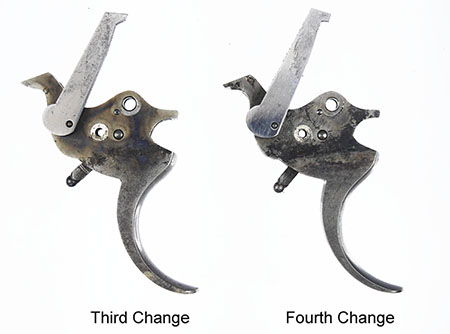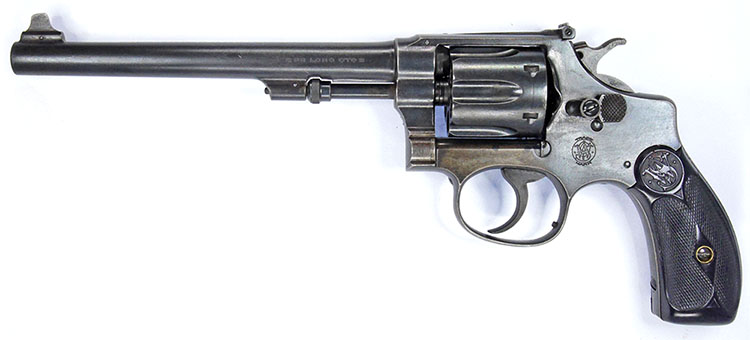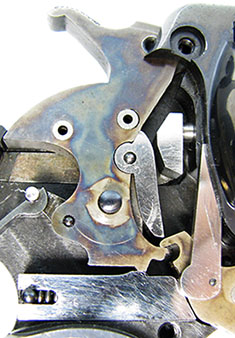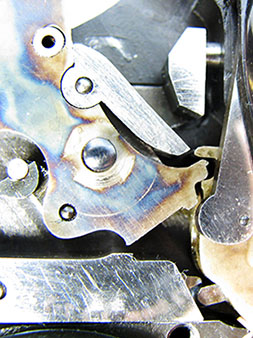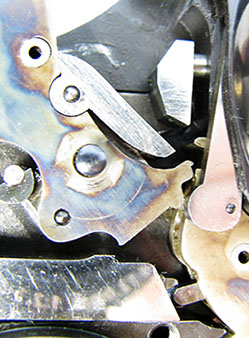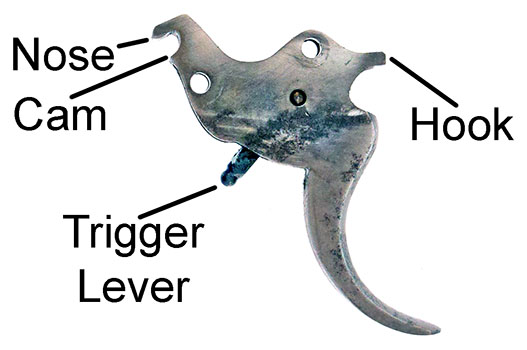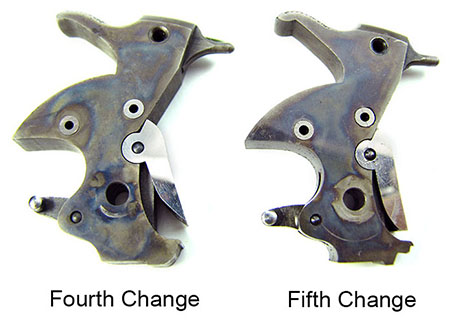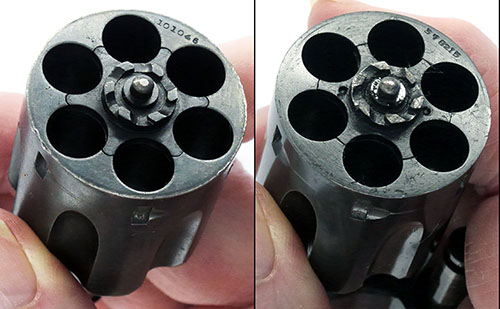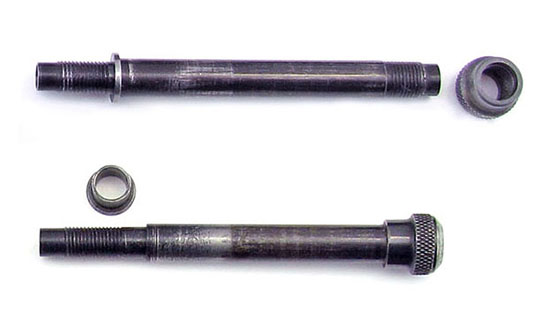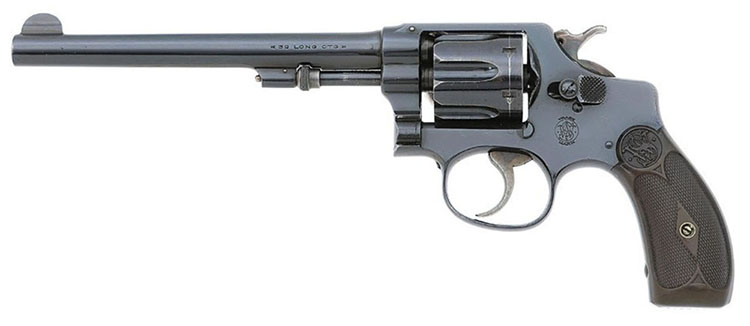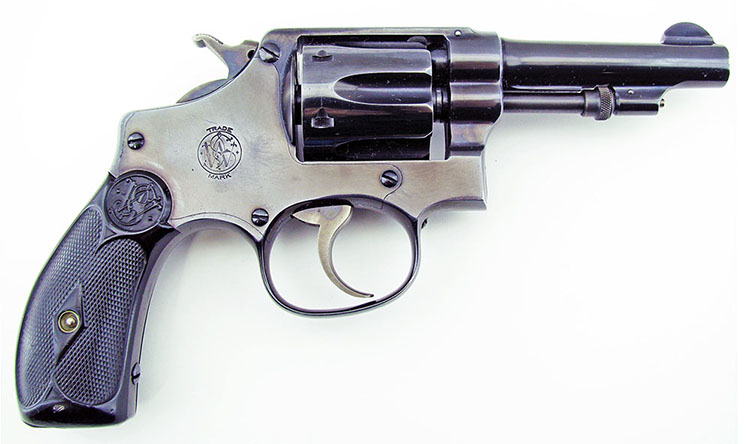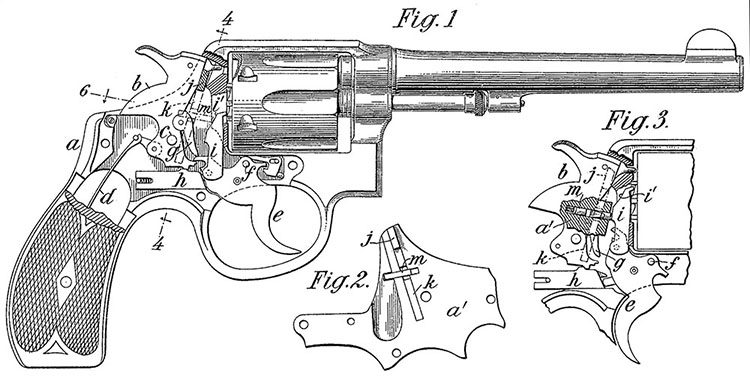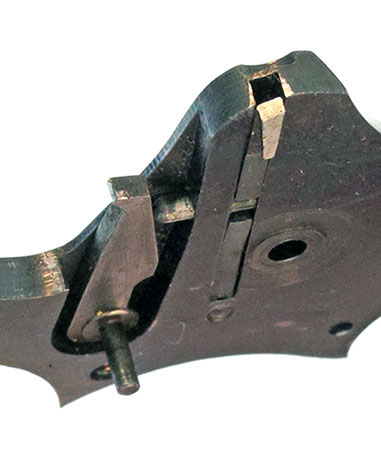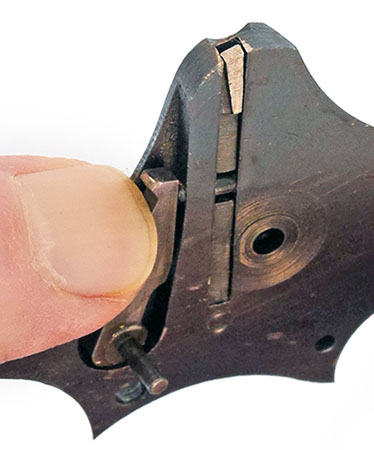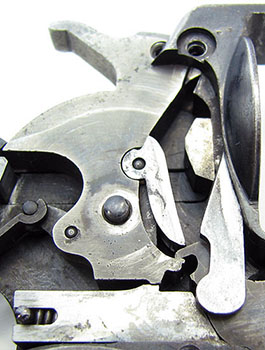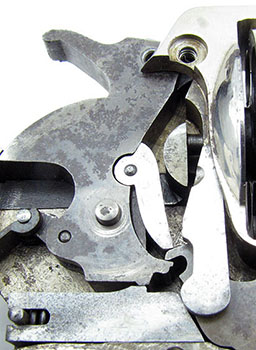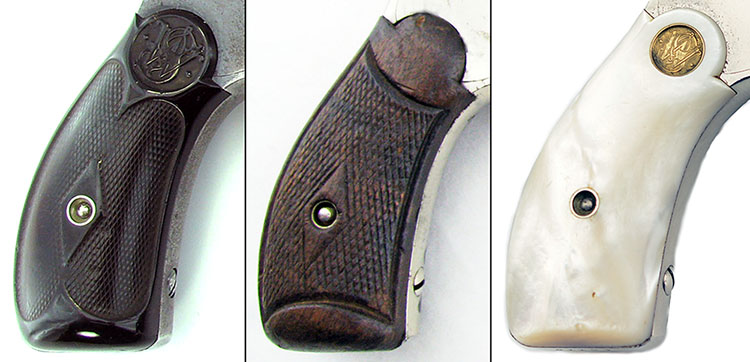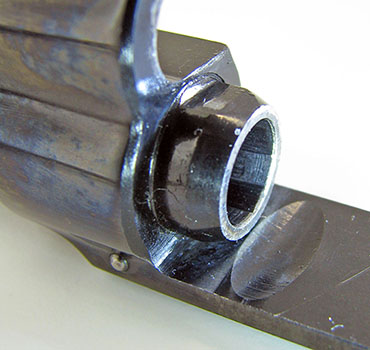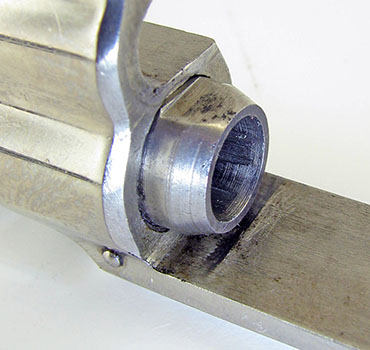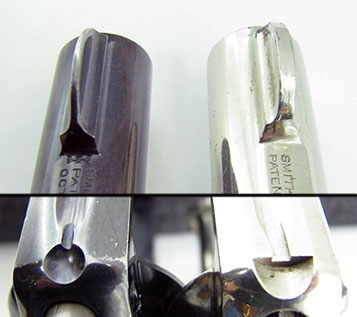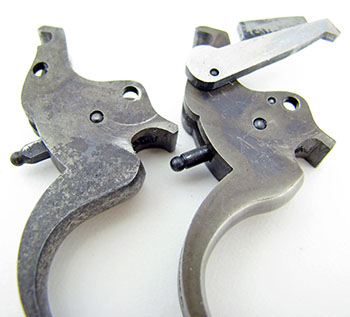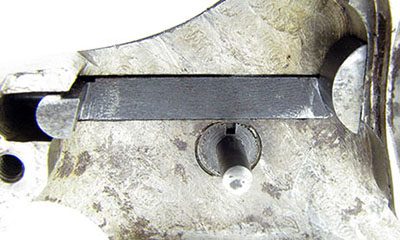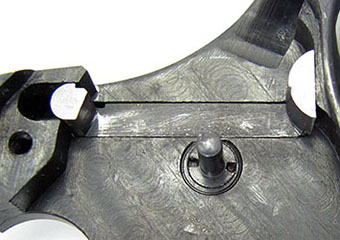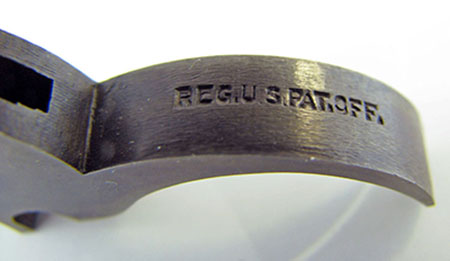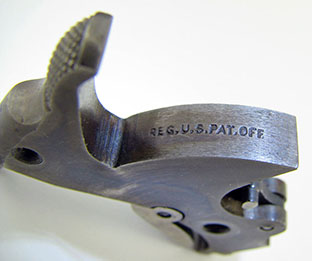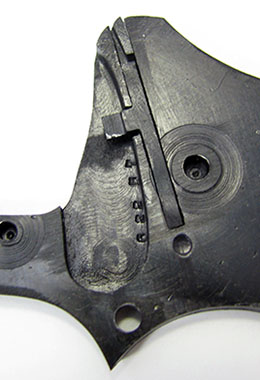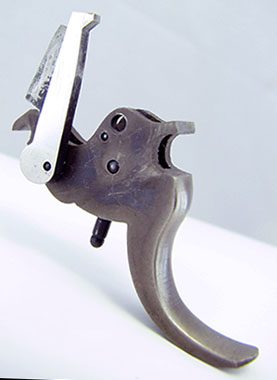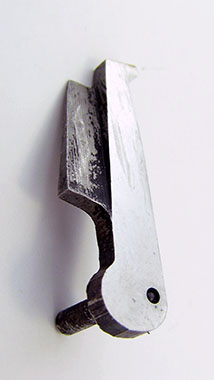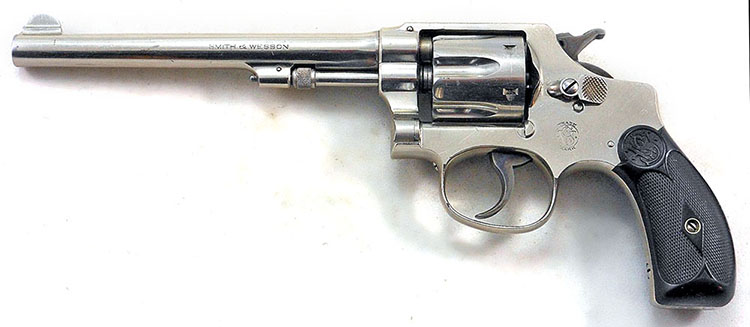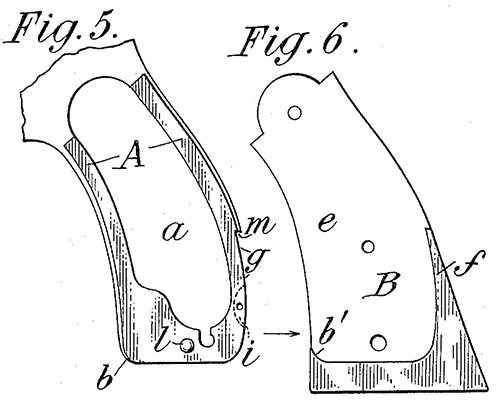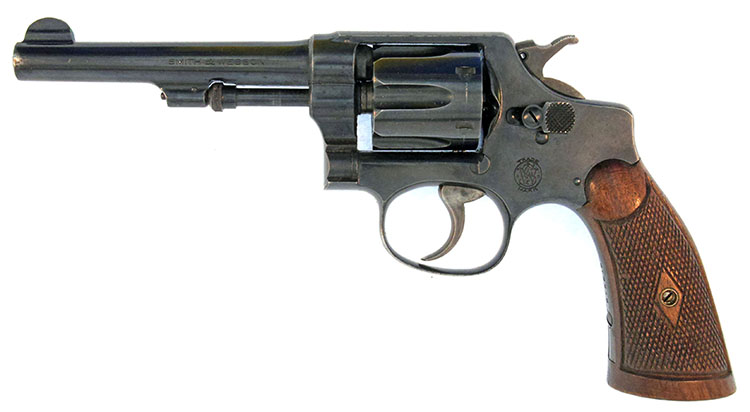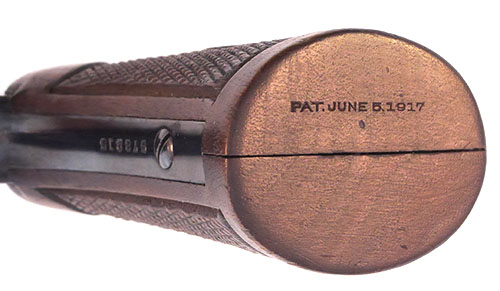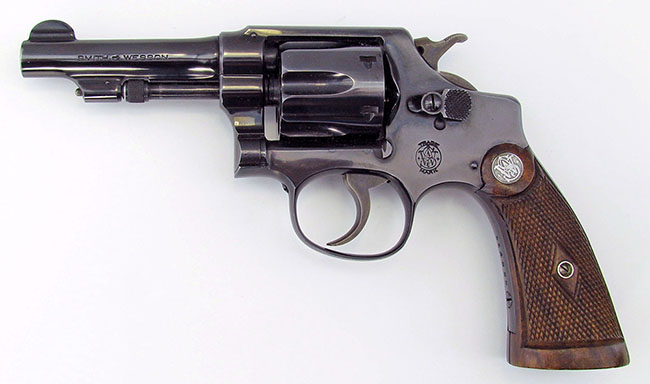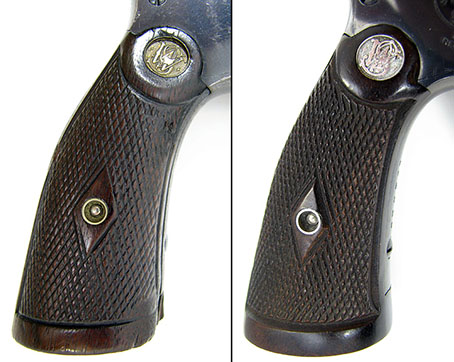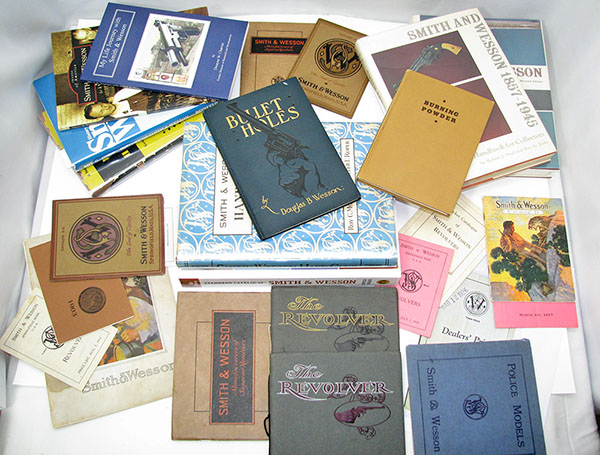 |
||||||||||||||||||||||||||||||||||||||||||||||||||||||||||||||||||||||||||||||||||||||||||||||||||||||||||||||||||||||||||||||||||||||||||||||||||||||||||||||||||||||||||||||||||||||||||||||||||||||||||||||||||||||||||||||||||||||||||||||||||||||||||||||||||||||||||||||||||||||||||||||||||||||||||||||||||||||||||||||||||||||||||||||||||||||||||||||||||||||||||||||||||||||||||||||||||||||||||||||||||||||||||||||||||||||||||||||||||||||||||||||||||||||||||||||||||||||||||||||||||||||||||||||||||||||||||||||||||||||||||||||||||||||||||||||||||||||||||||||||||||||||||||||||||||||||||||||||||||||||||||||||||||||||||||||||||||||||
|
The 1903 Smith & Wesson .32 Hand Ejector— Part 3—Fourth, Fifth, Sixth Change, by Ed Buffaloe and Gaston Comeau
This is a relatively scarce change, with only about 6,374 made. The Fourth Change is externally identical to the late Second Change, as well as the Third Change, and can only be identified by serial number or by a close examination of the hand. Hand The only alterations in this variation of the Model 1903 are a redesigned hand and an enlarged cut in the frame to accommodate it. McHenry and Roper comment: “Angle of throat made abrupt at point of recovery to allow time for stop to latch before hammer is released for double action fall. Hand slot in frame made to conform.”
The hand is difficult to measure, due to its shape, but the redesigned angle at the tip requires a larger cut in the frame to allow the hand to engage the cylinder at the correct angle. The frame cut appears to have been increased by about a quarter of a millimeter: we measure the height of the cut on serial number 95745 (Third Change) to be .325 inches (8.27 mm) and that of serial number 101046 (Fourth Change) to be .336 inches (8.55 mm). Observed cylinders remain unaltered. The hammer, rebound slide, and cylinder stop are identical to Third Change parts, with the exception that late rebound slides no longer display the patent date. Inscription A four line inscription (serial number 98348) is identical to that on Second and Third Change revolvers, in upper case sans serif characters, as follows: SMITH&WESSON SPRINGFIELD MASS. U.S.A.
A two line inscription on a six inch barrel (serial number 101046) reads as follows: SMITH&WESSON SPRINGFIELD MASS. U.S.A. PAT’D MARCH
This is one of the most common variants of the Model 1903, with approximately 160,500 made. The Model 1903 Fifth Change represents a major breakthrough for Smith & Wesson and set a new standard for double action trigger quality that remains the hallmark of Smith & Wesson revolvers to this day. Lockwork
On 14 October 1908, Charles M. Stone, presumably a Smith & Wesson employee, filed U.S. patent № 933797, which was granted on 14 September 1909. This patent claims to “...provide a construction...whereby when the hammer is cocked by the movement of the trigger the backward throw of the hammer will be through a longer arc...; and...as the hammer nears the end of its backward movement, and as the main spring tension or resistance increases, the point of engagement between the trigger and hammer is shifted whereby...the leverage of the trigger against the hammer is shortened to the end that at the time when the main spring resistance is the greatest, the power required to compress said spring will...be lessened...” The patent also claims that the new arrangement “...results in the most advantageous application of power to the hammer.” The toe of the hammer is undercut to create a narrower point. The rear shape of the new trigger reminds one of a can opener.
The double action sear is shortened and held closer to the body of the hammer so the nose of the trigger releases it sooner, but at the point of release the secondary ledge beneath the nose, referred to by Kuhnhausen as the cam, seamlessly engages with the projecting toe of the Fifth Change hammer to carry the hammer backward and release it at the end of the double action pull. The result is that the force necessary for the trigger to move the hammer is reduced right at the end of the double action arc, producing a lighter and smoother trigger pull.
McHenry and Roper comment that the chafing bushings are removed from the hammer in the Fifth Change; however, we have not observed this in the revolvers we have examined.
Bolt and Extractor McHenry & Roper state: “Bolt—Circle cut replacing angle cuts back of head omitting plunger screw .” Their language is terse and enigmatic, but it means that the shape of the bolt head was altered, to round from angled, and the screw retaining the spring and plunger was eliminated. We have not seen either alteration in the bolt of the late Fifth Change example we examined (serial number 224627) but perhaps it was implemented in very late production. Neal & Jinks do not mention this alteration. (See Sixth Change, below.)
The extractor was redesigned. In previous versions, the extractor was positioned using rounded ends on the star arms. The new extractor is positioned using two pins in the rear of the cylinder which fit into holes in the extractor face.
McHenry & Roper comment that the knurled extractor rod is “...made solid on rod with separate rod collar.” Neal & Jinks state: “The extractor rod knob was made solid instead of being screwed on as before,” but do not mention the collar.
Inscriptions and Marks The left side of the barrel is marked in upper case sans serif characters: 32 LONG CTG An early two line inscription (serial number 118633) does not contain the new 1909 patent date; the inscription is in upper case sans serif characters and reads as follows: SMITH&WESSON SPRINGFIELD MASS. U.S.A. PAT’D MARCH A later three line inscription (serial numbers 171641, 190835, 224627, and 228520) includes the new 1909 patent date, and reads as follows: SMITH&WESSON SPRINGFIELD MASS. U.S.A. Early Fifth Change revolvers have a small Smith & Wesson monogram on the left side, while some late examples have a large monogram on the sideplate on the right side. We have encountered a few late guns that have no monogram on either side.
“Sixth Change” is the terminology used for this variant by McHenry & Roper in their 1947 book, Smith & Wesson Hand Guns. The terminology currently in favor by collectors is “Third Model Hand Ejector”, as established by Neal & Jinks in their 1975 book Smith & Wesson: 1857-1945, whereas McHenry & Roper reserve the terminology “Third Model Hand Ejector” only for the Regulation Police model (see below). While there are good reasons for both usages, we feel it is a matter of semantical preference, and collectors should be aware of the differing terminologies. The Sixth Change sees the introduction of a hammer block in the sideplate. In all likelihood, Smith & Wesson encountered instances in which a gun was dropped hard enough that the rebound slide was ineffective, and the gun went off. In an attempt to prevent this, a hammer block was designed that fit neatly into the sideplate (see U.S. Patent № 1,122,635).
McHenry & Roper concisely describe the hammer block as follows: “Made as leaf spring located in side plate with head projection to operate between hammer face and frame when hammer rests at rebound, being withdrawn from this normal position only through the full rearward action of trigger at the instance of firing.” A spring and plunger in the sideplate tension the hand. As the trigger is pulled, the back of the hand pushes against the spring and plunger, causing the hammer block to retract into the sideplate.
The trigger assembly is simplified because the spring and lever to tension the hand are omitted. The back of the hand deactivates the hammer block as the trigger is pulled. According to McHenry & Roper, in later production the hand was “...changed to flat edge with notch cut for plunger to improve assembling of plate.” The early plunger in the sideplate has a bevel to aid in assembly, whereas in later production guns the bevel is moved to the back of the hand for the same purpose (see photograph below). According to Neal & Jinks, this change was ordered on 9 June 1920.
During production of the Sixth Change, chafing pins were eliminated, first in the trigger and, slightly later, in the hammer. Cylinder and Bolt McHenry & Roper state that cylinders of Sixth Change guns were heat treated beginning with serial number 321,000. This information is repeated by Neal & Jinks as well as Supica & Nahas. McHenry & Roper (as noted above, under the Fifth Change) state that the bolt head was modified from an angle cut shape to a rounded shape (as illustrated in the above photographs), and that the screw holding the plunger was eliminated from the rear of the bolt. They say these changes in the bolt took place in Fifth Change revolvers; however, we have not observed either alteration until the Sixth Change. Inscriptions, Markings, and Stocks The left side of the barrel is marked in upper case sans serif characters: SMITH & WESSON The right side of the barrel is marked in upper case sans serif characters: 32 LONG CTG The two line inscription includes the 1914 hammer block patent and reads: SMITH&WESSON SPRINGFIELD MASS. U.S.A. Like late Fifth Change revolvers, early Sixth Change revolvers are found with no Smith & Wesson monogram on either side, but in later production most examples have the small monogram on the left side of the frame. While checked walnut stocks were available fairly early in Model 1903 production, they are not often encountered, but with the sixth change their use becomes slightly more common. Early walnut stocks have a diamond around the screw escutcheon but no S&W monogram. Late production guns may be found with walnut grips with a brass medallion at the top.
Late Production Minor Changes Beginning in May of 1922, all Smith & Wesson revolvers were stamped on the right side of the frame, in front of the sideplate: MADE IN U.S.A. Neal & Jinks state that, as of 29 July 1922, all Hand Ejector barrels were ordered to be chamfered “to lead ball to rifling without shearing”. This means that a slight chamfer was added to the rifling at the rear of the barrel to prevent small bits of lead from shearing off the bullet. Clearly, sometime in this period, the fouling cup was also eliminated.
According to Neal & Jinks, two changes were ordered on 14 August 1923. All .32 and .38 hand ejector revolvers were to have square front sights, and the trigger lever shape on I and K frame revolvers was changed from square to round “to facilitate manufacture”.
We note an otherwise unrecorded minor change: an additional cut was added to the rear of the bolt on Sixth and Seventh Change revolvers.
Beginning in June of 1926, all Hand Ejector hammers and triggers are stamped with: REG. U.S. PAT. OFF.
According to Neal & Jinks, beginning in December of 1926, a new hammer block and redesigned hand were installed in the Hand Ejector revolvers, described by them as “...a leaf spring operated by a ramp on the hand.” As the hand moves up when the trigger is pulled, the ramp forces the leaf spring back into the sideplate.
Production Numbers and Identification Serial numbers run concurrently with those of the Regulation Police (see below). Because the exterior of the Sixth Change is identical to the Fifth Change, the first Sixth Change serial number is not known exactly, nor do we know the total number made. A parts illustration for the .32 Hand Ejector that includes the sideplate safety did not appear until the 1924 Smith & Wesson catalog, leading us to believe that the transition from Fifth to Sixth Change Hand Ejector may have occurred later than is generally accepted.
We have not documented a Sixth Change gun that lacks the 1914 patent date; for the most part, the presence of the 1914 patent date is an accurate way of determining a Sixth Change revolver. A definitive means is to verify the presence of the hammer block; it can be seen if the hammer is drawn back slightly. The lowest .32 Hand Ejector Sixth Change serial number we have observed is 313416, but our database is very limited. According to Neal & Jinks, the highest serial number recorded is 534,532. Please write to us if you have an early Hand Ejector with the hammer block; please include photographs and your serial number.*
Joe Wesson’s last patent was filed 29 December 1916 and was granted on 5 June 1917 as U.S. patent № 1,228,506, but the Regulation Police model for which it was designed was already in production by the time the patent was granted. The patent was for a simple undercut grip frame that allowed an oversize grip to be securely fitted to the gun.
McHenry & Roper state: “...the .32 Regulation Police Model was announced in February, 1917.” At the same time, Smith & Wesson introduced a five-shot .38 caliber version chambered for the .38 Smith & Wesson cartridge. Catalog D does not show the Regulation Police revolver, but its accompanying price list, dated March 1st, 1917, lists both the .32 and .38 versions of the new gun. In the 11 November 1916 issue of Hardware Age magazine, Douglas Wesson penned a brief article entitled “A New Light-Weight Revolver” which is worth quoting at some length: The Ideal side arm for the roundsman or watch man has always been a comparatively small, light-weight weapon, that could
be carried with a minimum of discomfort and still be powerful enough to stop a dangerous character, accurate enough to hold
its shots in a “two-inch bull” at 20 yd., and reliable enough to relieve the mind from all worry as to the chances of failure to operate, etc. According to Douglas Wesson, the defining features of the Regulation Police model are its heat treated alloy steel parts, safety hammer block, and undercut grip frame to accommodate oversize stocks, but he does not mention that the new model will also be available in the .32 S&W Long cartridge. In fact, the .38 Regulation Police revolver is marked REGULATION POLICE on the right side of the barrel, whereas the .32 version is not so marked, despite its being designated as such in catalogs and price lists. Judging from Wesson’s article, the .38 version of the Regulation Police was very likely the primary marketing concern of the company, being the first .38 built on the small I frame. The .32 version of the Regulation Police may have been an afterthought. The .32 cartridge was still in use by some police departments but the .38 cartridge was usually considered more suitable for police work.
In our humble opinion, the change in the grip frame is so minor as to be undeserving of a new model designation, and, in fact, we do not find the Regulation Police (or the Sixth Change, for that matter) listed as the “Third Model Hand Ejector” in any Smith & Wesson catalog. We do not know where the terminology originated, but it appears to predate McHenry & Roper. The Regulation Police .32 is clearly just another change, in a long line of changes, to the Model 1903 Hand Ejector. The .32 caliber Regulation Police serial numbers are intermixed with those of the Sixth Change .32 Hand Ejector, whereas the .38 Regulation Police has its own serial number sequence. Markings on the .32 Regulation Police are identical to those on the Sixth Change .32 Hand Ejector. The only real difference is the undercut grip frame and the oversize wooden stocks. Even the inscription on top of the barrel remains the same. Instead of adding the patent for the stocks to the barrel inscription, Smith & Wesson stamped the patent date on the bottom of the left stock, enabling them to use the same roll stamp on the barrels for both Sixth Change Hand Ejectors and Regulation Police revolvers.
Like Sixth Change revolvers, early Regulation Police are found with no S&W monogram on either side, but most guns have the small monogram on the left side. We have identified at least one late gun (serial number 530711) with a small monogram on the left side and a large monogram on the right side. There may be more.
As a result of the stocks covering the bottom of the grip frame, the serial number on the Regulation Police is moved to the front grip strap. Late stocks have a Smith & Wesson monogram medallion at the top. The earliest ones were brass, but the majority are chrome plated.
The lowest serial number we have recorded for a .32 Regulation Police revolver is 259193. The reader will note that this is much lower than the lowest serial number observed for a Sixth Change revolver. Based on our limited database, we suspect that the Regulation Police .32 preceded the Sixth Change .32, possibly by several years, and that our tentative designations of Sixth and Seventh Change should probably be reversed, but we will leave this decision to future historians. One might suspect that Smith & We Production of the so-called Third Model Hand Ejector continued until the U.S. entry into World War II. Neal & Jinks state that the highest serial number recorded for a .32 Regulation Police is 536,685. *Write to edbuffaloe@unblinkingeye.com.
Part 1: Introduction and No Change Part 2: First and Second Change
|
||||||||||||||||||||||||||||||||||||||||||||||||||||||||||||||||||||||||||||||||||||||||||||||||||||||||||||||||||||||||||||||||||||||||||||||||||||||||||||||||||||||||||||||||||||||||||||||||||||||||||||||||||||||||||||||||||||||||||||||||||||||||||||||||||||||||||||||||||||||||||||||||||||||||||||||||||||||||||||||||||||||||||||||||||||||||||||||||||||||||||||||||||||||||||||||||||||||||||||||||||||||||||||||||||||||||||||||||||||||||||||||||||||||||||||||||||||||||||||||||||||||||||||||||||||||||||||||||||||||||||||||||||||||||||||||||||||||||||||||||||||||||||||||||||||||||||||||||||||||||||||||||||||||||||||||||||||||||
|
||||||||||||||||||||||||||||||||||||||||||||||||||||||||||||||||||||||||||||||||||||||||||||||||||||||||||||||||||||||||||||||||||||||||||||||||||||||||||||||||||||||||||||||||||||||||||||||||||||||||||||||||||||||||||||||||||||||||||||||||||||||||||||||||||||||||||||||||||||||||||||||||||||||||||||||||||||||||||||||||||||||||||||||||||||||||||||||||||||||||||||||||||||||||||||||||||||||||||||||||||||||||||||||||||||||||||||||||||||||||||||||||||||||||||||||||||||||||||||||||||||||||||||||||||||||||||||||||||||||||||||||||||||||||||||||||||||||||||||||||||||||||||||||||||||||||||||||||||||||||||||||||||||||||||||||||||||||||
|
Copyright 2024 by Ed Buffaloe and Gaston Comeau. All rights reserved. |
||||||||||||||||||||||||||||||||||||||||||||||||||||||||||||||||||||||||||||||||||||||||||||||||||||||||||||||||||||||||||||||||||||||||||||||||||||||||||||||||||||||||||||||||||||||||||||||||||||||||||||||||||||||||||||||||||||||||||||||||||||||||||||||||||||||||||||||||||||||||||||||||||||||||||||||||||||||||||||||||||||||||||||||||||||||||||||||||||||||||||||||||||||||||||||||||||||||||||||||||||||||||||||||||||||||||||||||||||||||||||||||||||||||||||||||||||||||||||||||||||||||||||||||||||||||||||||||||||||||||||||||||||||||||||||||||||||||||||||||||||||||||||||||||||||||||||||||||||||||||||||||||||||||||||||||||||||||||
|
|
||||||||||||||||||||||||||||||||||||||||||||||||||||||||||||||||||||||||||||||||||||||||||||||||||||||||||||||||||||||||||||||||||||||||||||||||||||||||||||||||||||||||||||||||||||||||||||||||||||||||||||||||||||||||||||||||||||||||||||||||||||||||||||||||||||||||||||||||||||||||||||||||||||||||||||||||||||||||||||||||||||||||||||||||||||||||||||||||||||||||||||||||||||||||||||||||||||||||||||||||||||||||||||||||||||||||||||||||||||||||||||||||||||||||||||||||||||||||||||||||||||||||||||||||||||||||||||||||||||||||||||||||||||||||||||||||||||||||||||||||||||||||||||||||||||||||||||||||||||||||||||||||||||||||||||||||||||||||
